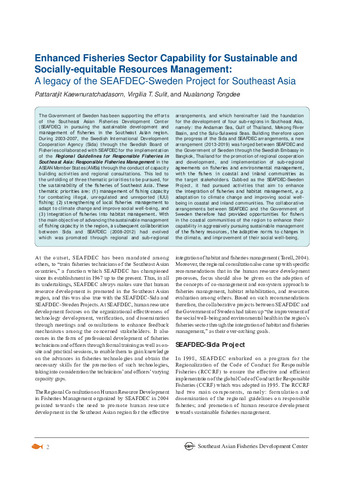| dc.description.abstract | The Government of Sweden has been supporting the efforts of the Southeast Asian Fisheries Development Center (SEAFDEC) in pursuing the sustainable development and management of fisheries in the Southeast Asian region. During 2003-2007, the Swedish International Development Cooperation Agency (Sida) through the Swedish Board of Fisheries collaborated with SEAFDEC for the implementation of the Regional Guidelines for Responsible Fisheries in Southeast Asia: Responsible Fisheries Management in the ASEAN Member States (AMSs) through the conduct of capacity building activities and regional consultations. This led to the unfolding of three thematic priorities to be pursued, for the sustainability of the fisheries of Southeast Asia. These thematic priorities are: (1) management of fishing capacity for combating illegal, unregulated and unreported (IUU) fishing; (2) strengthening of local fisheries management to adapt to climate change and improve social well-being, and (3) integration of fisheries into habitat management. With the main objective of advancing the sustainable management of fishing capacity in the region, a subsequent collaboration between Sida and SEAFDEC (2008-2012) had evolved which was promoted through regional and sub-regional arrangements, and which hereinafter laid the foundation for the development of four sub regions in Southeast Asia, namely: the Andaman Sea, Gulf of Thailand, Mekong River Basin, and the Sulu-Sulawesi Seas. Building therefore upon the progress of the Sida and SEAFDEC arrangements, a new arrangement (2013-2019) was forged between SEAFDEC and the Government of Sweden through the Swedish Embassy in Bangkok, Thailand for the promotion of regional cooperation and development, and implementation of sub-regional agreements on fisheries and environmental management, with the fishers in coastal and inland communities as the target stakeholders. Dubbed as the SEAFDEC-Sweden Project, it had pursued activities that aim to enhance the integration of fisheries and habitat management, e.g. adaptation to climate change and improving social wellbeing in coastal and inland communities. The collaborative arrangements between SEAFDEC and the Government of Sweden therefore had provided opportunities for fishers in the coastal communities of the region to enhance their capability in aggressively pursuing sustainable management of the fishery resources, the adaptive norms to changes in the climate, and improvement of their social well-being. | en |

